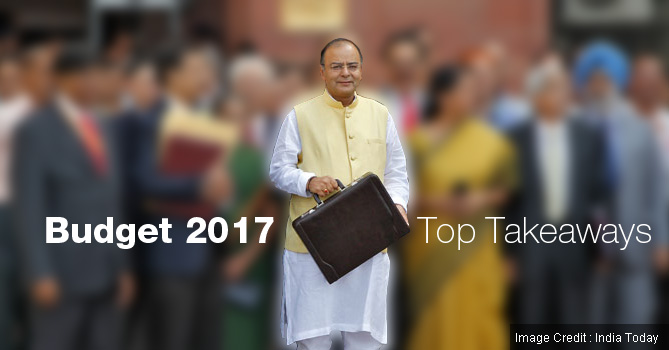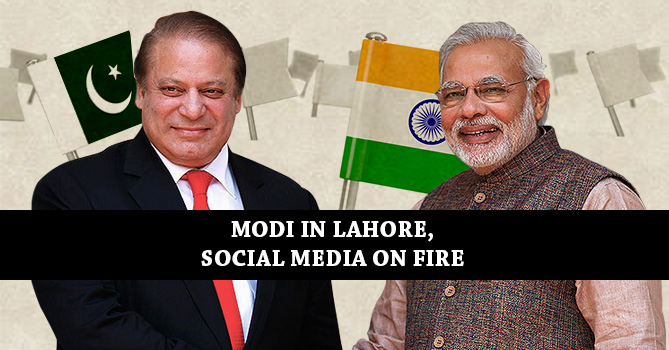
Vasant Panchami or Basant Panchami heralds the onset of spring. It is celebrated across the country. On this auspicious occasion, India’s Finance Minister Mr Arun Jaitley presented independent India’s first combined Union and Railways budget. Here are some of the key takeaways for the Indian Budget for FT 2017-18 –
- Highlighting the move from a “discretionary based administration to a policy and system based administration” (sic), the FM said that inflation, a major concern, has been largely controlled and a massive war has been launched on the menace of black money. CPI inflation decreased from 6 in percent July 2016 to in 2.4 percent December 2016. CAD declined from 1 percent of GDP last year to about 0.3 percent of GDP this year. FDI increased from INR 1,07,000 to INR 1,45,000 crore this year. Foreign exchange reserve has increased to USD 361 billion.
- The IMF estimates that the world GDP shall grow by 3.1 percent in FY 16 and in FY17, shall grow by 3.4 percent. At a time when advanced economies are looking forward to see their growth to increase from 1.6 percent to 1.9 percent and emerging economies from 4.1 percent to 4.5 percent, India is seen as a shining “engine of global growth”. India is expected to be one of the fastest growing economies in 2017 and is now the 6th largest manufacturing country in the world.
- Tectonic reforms undertaken by the government – GST and demonetisation. “Demonetisation is a bold and decisive measure” and will create a bigger, more real, cleaner GDP.
- IMF’s forecast for India’s GDP growth for FY 17 is 7.2 percent and for FY 18 is 7.7 percent.
- In FY 2017-18, the government shall spend more on infrastructure development, on poverty alleviation, and on development of rural areas. At the same time, fiscal prudence shall remain a guiding principle of the budget. The schemes announced shall be implemented before the onset of monsoon.
- Transform, Energise and Clean India – this shall be at the centre of the government’s agenda for FY 2017-18.
Farmers /Agricultural Sector –
- The government is committed to double farm income in five years. Agriculture expected to grow at 4.1 percent in the current FY. Agricultural credit target for the FY 17-18 has been fixed at INR 10 lakh crore. 60 day loan waiver extended to farmers.
- Government will support NABARD in setting up and computerization of 63,000 functional PACs (primary agricultural credit societies) at a cost of about INR 1900 crore. Fasal Bima Yojana will cover a cropped area of 40 percent 2017-18, and 50 percent in FY 2018-19.
- Mini labs to be set up for soil testing in all 648 krishi vigyan kendras in the country. These will cover 100 percent issuance of soil health cards.NABARD to set up a dedicated micro-irrigation fund with an initial corpus of INR 5000 crore to achieve greater crop in irrigated land. The FM also said that a Dairy processing Infrastructure Fund of INR 8000 crore will be set up.
Rural Sector –
- The government aims at bringing 1 crore households out of poverty and make 50,000 Gram Panchayats poverty- free by FY 2019.
- FM makes a budget allocation of INR 48,000 crore (highest ever) for MNREGA in 2017-18; in 2016-17 the allocation was INR 37,000 crore.Women’s participation in MGNREGA has gone up to 55 percent.
- Geotagging of MNREGA projects has improved efficiency and transparency. 133 km roads/day built under the PMGSY in 2016-17 up from 73 km/day in 2011-14. INR 27,000 crore allocated Pradhan Mantri Gram Sadak Yojana
- 1 crore houses will be available for homeless and those living in kaccha houses. INR 23000 crore allocated to PMAY (Gramin). 100 percent village electrification to be achieved by May 2018.Sanitation in rural areas has increased from 42 percent in 2014 to 60 percent.
- The total budget allocation for agricultural, rural, and allied sectors in INR 1,87,223 crore (FY 2017-18) – 24 percent higher than last year.
Youth –
- The government proposes a system of measuring annual learning outcomes in schools. Skill centres (Pradhan Mantri Kaushal Kendras) to be set up across 600 districts of India and a number of educational reforms will be taken up.
Poor And Underprivileged –
- INR 500 crore allocated to setting up Mahila Shakti Kendras in 14 lakh Anganvadi centres to empower women
- PM has already announced INR 6000 for pregnant women for institutionalized birthing.
- Allocation for women’s schemes INR 1,84,632 crores.
Social Development/Poverty –
- Affordable housing will now receive infrastructure status.
- Government targets elimination of tuberculosis by 2025, leprosy by 2018, measles by 2019. Two new AIIMS will be built in the states of Gujarat and Jharkhand. 1.5 lakh Health Wellness centres to be set up at the health care centres of the country. 25000 PG courses will be available in medical colleges.
- Aadhar based health cards will be available for senior citizens.
- Labour laws and payment of wages laws are up for reforms this year. Scheduled Caste development budgetary allocation increased to INR 52,393 crore and Scheduled Tribe allocation to INR 31,920 crore and minority allocation INR 4195 crore.
Railways, Roads, and Transport –
- Total budget allocation for Railways is INR 55,000 crore; total expected expenditure 1,31,000 crore.
- A safety fund will be set up for railways safety with a corpus of INR 1 lakh crore (over 5 years)
- By 2020, unmanned level crossings will be eliminated in the country. Over 500 stations will be made accessible to differently abled.
- The focus on Swachh Railways will continue, Coach Mitra facility will be introduced to address coach related complaints. All rail coaches will have bio toilets by 2019.
- In the next FY 3500 km new lines will be laid and 2000 stations powered by solar energy. Logistics process, accounts and finances will be reformed and a metro rail policy formulated.
- No service charge on e-tickets
- Budget allocation of INR 64000 crore for national highways; for transport sector at INR 2,41,387 crore.
- Roads have been built for 1,40,000 km since 2014; 2000 km coastal roads will be developed.
- Selected airports in Tier 2 cities will start operations in the PPP mode
Other Sectors –
- OFC laid over 1,55,000 km. Bharat net project receives an allocation of INR 10,000 crore. High speed broadband internet will be made available in 1,50,000 gram panchayats across India.
- Digi Gaon will be launched to provide tele-medicine, skills, and education through digital technology.
- Two more crude oil reserves to be set up in Odisha and Rajasthan.
- Next leg of solar power development will aim at generating 20,000 MW.
- New scheme called Trade Infrastructure Export Scheme will be launched in in FY 18.
- The total allocation for infrastructure stands at record INR 3,96,135 crore.
- A new and reformed FDI policy will replace FIBP.
- Further divestment of public sector companies to be expected this year; IRCTC to be listed.
- PM Mudra Yojna lending target doubled to INR 2.44 lakh crores.
- BHIM app adopted by 125 lakh people; 2 new schemes will be launched to promote use of BHIM
- Target of 2500 crore for digital transactions this FY.
- Head Post Offices will function as Passport Offices.
- Central Defence Travel System will facilitate travel for defence personnel. Defence pensioners will receive pensions and register complaints through a specialized website.
- Government to enact law to confiscate assets of tax offenders who flee the country.
- 150th birth anniversary of Mahatma Gandhi will be celebrated in a grand fashion.
Fiscal Details –
- Total expenditure of the 2017-18 budget is pegged at INR 21.47 lakh crore.
- Capital expenditure increased by over 25.4 percent.
- Revenue transferred to States and UT INR 4.11 lakh crores.
- Allocation for scientific ministries INR 37435 crore.
- Defence budget allocation INR 2.74 lakh crore for this fiscal.
- Fiscal deficit target fixed by FM for this fiscal is 3.2 percent of GDP; revenue deficit pegged at 1.9 percent.
Taxation –
- India’s tax to GDP ratio is very low; the proportion of direct tax to indirect tax in the country is not optimal.
- only about 5.97 lakh registered companies only 13.94 lakh companies have filed tax returns for FY 16-17, 2.7 lakh companies have shown zero income or losses.
- Of 3.7 crore individuals who filed taxes, 99 lakh showed income below taxable limits, only 1.95 crore assessees filed an income between INR 2.5 lakh to INR 5 lakh, 24 lakh assesses show income over INR 5 lakh.
- 56 lakh of the 76 lakh individual tax assessees showing income over INR 5 lakh are salaried.
- Only 1.72 lakh people in the entire country showed income over INR 50 lakh a year.
- We are a largely tax non-compliant society.
- Between 8 November to 30 December 2016, deposits between INR 2 lakh to INR 80 lakh were made in 1.09 crore bank accounts, average deposits of INR 5.03 lakhs made.
- Advance tax payments of individual assesses grew by 34.8 percent in the last three quarters of this FY.
- Houses which remain unoccupied after receiving completion certificate will attract tax (after 1 year).
- Holding period for long term capital gain of immovable assets lowered to two years from three years; base year for indexation will be 2001.
- Proposal to have a carry-forward of MAT for 15 years.
- Persons holding land has been pooled for creation of the state capital of Andhra Pradesh are exempt from capital gains tax.
- MSME companies generate much employment should be made more viable. FM proposes to reduce tax for companies with a turnover of up to INR 50 crore by 5 percent. About 96 percent of companies will be able to avail of this benefit.
- Basic customs duty on LNG halved from 5 percent to 2.5 percent
- Charitable trusts cannot receive cash donation over INR 2000.
- No transaction over INR 3 lakh in cash will be permitted.
Political Funding
- No political party can receive cash donation over INR 2000 from any one source; higher donations may be made by cheque or digital payments.
- A scheme of Electoral Bond is to be launched by the RBI; donors may purchase bonds from banks (through cheque or digital payments); the parties may encash these through their designated official accounts.
Personal Income Tax
- No personal income tax for individuals with income up to INR 3 lakh
- Existing rate of taxation for individuals with income between INR 2.5 lakh and INR 5 lakh reduced to 5 percent
- All other income categories will receive benefits up to INR 12,500
- Additional 10 percent surcharge on people with incomes between between INR 50 lakh and INR 1 crore, 15 percent surcharge on individual income over INR 1 crore to continue




